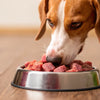How to Switch to a Raw Food Diet for Dogs: A Comprehensive Guide
- Houndsy
Table of Contents
- Introduction
- Understanding Raw Diets and Their Advantages
- Preparing for the Transition
- Transitioning Your Dog to a Raw Diet
- Common Mistakes in Switching to a Raw Diet
- Observing Changes and Benefits
- The Role of Houndsy in Your Dog Feeding Routine
- Conclusion
- FAQs
Introduction
As pet owners, we are always striving to give our dogs the best—best toys, best grooming, and most importantly, the best food. But what if the food we've considered the standard—kibble—has been limiting our pets' health? It's a startling thought, considering that studies indicate that many chronic health issues in dogs, such as obesity, allergies, and diabetes, may stem from dietary choices. As we delve into this subject, we aim to provide you with actionable insights on how to switch to a raw food diet for your dog, enabling you to elevate their meals while also enhancing their happiness and well-being.
In this article, we will explore the ins and outs of transitioning your dog to a raw food diet. We will guide you through the benefits, methods to facilitate the transition, common mistakes to avoid, and the essential nutrition principles to keep in mind. If you've ever wondered how to make this shift smoothly, you're in the right place! By the end of this post, you will have a thorough understanding of how to effectively and healthily make this dietary change for your furry friend.
Understanding Raw Diets and Their Advantages
What Is a Raw Food Diet for Dogs?
A raw food diet—often called a "biologically appropriate raw food" (BARF) diet—consists primarily of uncooked meat, bones, fruits, and vegetables. The idea is to mimic the natural diet of canines as observed in the wild. This shift aims to eliminate the preservatives and low-quality ingredients commonly found in commercial dog foods and promote better overall health.
Benefits of Transitioning to a Raw Food Diet
Switching to a raw food diet can offer numerous positives, including:
- Improved Coat Health: Many pet owners report shinier, healthier coats due to the increase in natural fats and oils derived from fresh meats.
- Enhanced Digestion: Raw foods typically contain no fillers or synthetic additives, leading to more efficient digestion.
- Higher Energy Levels: The nutrient density in fresh food can provide sustained energy levels throughout the day.
- Weight Management: Raw food is high in protein and low in carbohydrates, which can assist in maintaining a healthy weight.
- Reduced Allergies: Many dogs who switch to raw food see a reduction in sensitivities and allergic reactions linked to commercial food ingredients.
It's crucial that these benefits are not just anecdotal; scientific studies indicate that unprocessed and natural diets closely align with a dog's ancestral feeding patterns.
Preparing for the Transition
Evaluating Your Dog's Health
Before making any dietary adjustments, we must consider our pets’ health status. A trip to the vet is a responsible step to rule out any underlying health issues and to discuss your plans. This builds a support system and reassures you that you're making a safe choice for your dog.
Gathering Resources and Information
Familiarize yourself with raw feeding principles, types of raw foods, and recommended ingredient ratios. This groundwork will avoid common pitfalls and mistakes during your transition journey.
Choosing the Right Raw Food Options
Deciding between raw meats, whole prey, and commercial raw diets can be overwhelming. We suggest beginning with well-researched raw food brands that offer ready-made meals, like ground varieties—these can significantly simplify your feeding routine without sacrificing quality.
Transitioning Your Dog to a Raw Diet
Methods of Transition
When it comes to switching to a raw food diet for your dog, you generally have two approaches: gradual and instant.
1. Gradual Transition
Recommended for most dogs, particularly those with sensitive stomachs or older pets:
- Phase 1: Start by substituting 10-20% of their current diet with raw food.
- Phase 2: Monitor their reaction for about three days. If stool consistency remains firm and your dog shows no signs of distress, gradually increase the raw food to 30-50% and continue adjusting until they are on a fully raw diet.
- Phase 3: This transition can take anywhere from a week to six weeks, depending on your dog's adaptability.
2. Instant Transition
More suitable for healthy, resilient dogs:
- Day 1: You can choose to fast your dog for one meal to prep for introducing raw food.
- Day 2: Serve your dog 100% raw food.
An instant switch may lead to digestive issues, so it's worthwhile to gauge your dog's reaction closely during this process.
Example Schedule for Gradual Transition
- Day 1: 80% kibble, 20% raw
- Day 3: 60% kibble, 40% raw
- Day 5: 40% kibble, 60% raw
- Day 7: 20% kibble, 80% raw
- Day 10: 100% raw
Essential Considerations During Transition
To ensure a successful shift to a raw diet, keep in mind the following:
- Monitor your dog’s stool for consistency. Soft or loose stools may indicate that you need to slow down the transition.
- Ensure a balanced diet by incorporating a variety of meats, bones, organs, and vegetables. This may include muscle meat, raw meaty bones, and nutritious organ meat like liver.
- Avoid sudden introductions to new ingredients—all changes should be gradual for best digestion.
Common Mistakes in Switching to a Raw Diet
Even with the best intentions, mistakes can occur. We should be mindful of the following pitfalls:
- Rushing the Transition: Jumping straight to raw food can result in gastrointestinal issues. Allow your dog time to adapt.
- Inadequate Research: Ensure that you've gathered sufficient knowledge about raw feeding guidelines and nutrient requirements.
- Feeding Unsuitable Bones or Meat: Avoid bones that pose risks of splintering, and be cautious with enhanced meats.
- Neglecting Nutritional Balance: Aim to provide a comprehensive diet by including all necessary food types in correct proportions.
Structural Guidelines for Nutritional Balance
- 50-70% Muscle Meat: Essential for protein intake.
- 10-20% Raw Meaty Bones: Provide calcium and assist dental health.
- 5-10% Organ Meat: Crucial for nutrient absorption.
- Variable Fruits & Veggies: Add fiber and additional nutrients.
Observing Changes and Benefits
Parameters for Assessing Adjustment
Once you've successfully transitioned your dog to a raw food diet, you'll want to keep an eye on:
- Coat Quality: Look for increased shine and vitality.
- Energy Levels: Increased stamina and activity are promising signs.
- Stool Quality: Should become firmer and well-formed as your dog’s digestive system adapts.
Potential Detox Symptoms
You may notice some temporary detox symptoms during the adjustment phase, including:
- Mild digestive upset (loose stools, gas)
- Increased thirst (due to the moisture content of raw foods)
- Fluctuations in hunger levels
These symptoms should resolve within a week or two. Remember, nutritional changes can cause temporary disruption, but ongoing persistence will yield great results for your pup.
The Role of Houndsy in Your Dog Feeding Routine
As we embrace this journey towards a better feeding experience, it’s important to have a system that simplifies and elevates how we care for our pets. The Houndsy Kibble Dispenser epitomizes this blend of design and functionality. With a convenient crank for portion control and a chic aesthetic, it ensures you can efficiently manage meal times without the fuss. Learn more about how it can complement your pet feeding routine by visiting Houndsy's Kibble Dispenser.
Conclusion
We’ve taken a deep dive into the process of transitioning your dog to a raw food diet—empowering you to make an informed decision for your beloved companion. By understanding the basics of raw feeding, the methods of transition, potential hurdles, and the necessary nutritional components, you equip yourself with the necessary tools for success. Remember, this journey is as much about enhancing your pet's quality of life as it is about changing their diet.
As always, monitor your dog closely during this transition, and stay positive! This adjustment can yield incredible benefits, from improved energy levels to increased vitality. Are you ready to take the leap and switch to a raw food diet for your dog? Let us know how it goes!
FAQs
1. Is transitioning to a raw food diet safe for all dogs?
While generally safe, it’s always best to consult your veterinarian, especially if your dog has health issues or dietary sensitivities.
2. How can I ensure my dog’s diet is balanced on raw food?
Incorporate a variety of protein sources, raw bones, organ meat, and some vegetables and fruits. Research proper ratios beforehand to maintain balance.
3. How long does it take for dogs to adjust to a raw food diet?
Adjustment can vary, taking anywhere from a few days to several weeks, depending on your dog’s unique needs and previous diet.
4. What should I do if my dog refuses to eat the new raw food?
Continue to offer it as a treat and mix it with familiar foods until your dog starts to accept it. Warm it slightly or change its consistency to entice them.
5. Can I mix raw food with kibble?
While it's typically advised to avoid combining these diets in one meal, you may feed them separately at different times in the day. The critical focus is on monitoring their response to either food type.
As you navigate this raw food journey, remember that providing a loving and nourishing environment will not only improve your dog's health but also strengthen the bond you share. Happy feeding!












